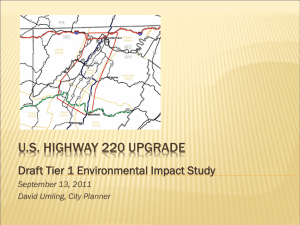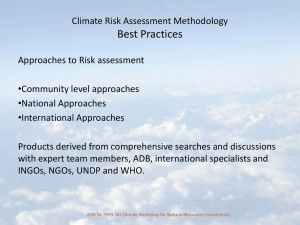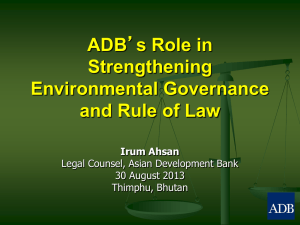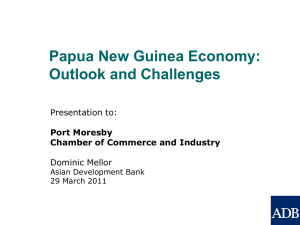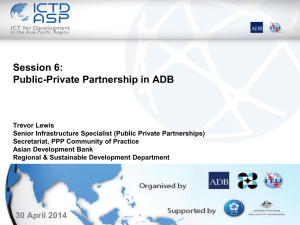Axes, nodes and transport modes in the South East Europe area
advertisement
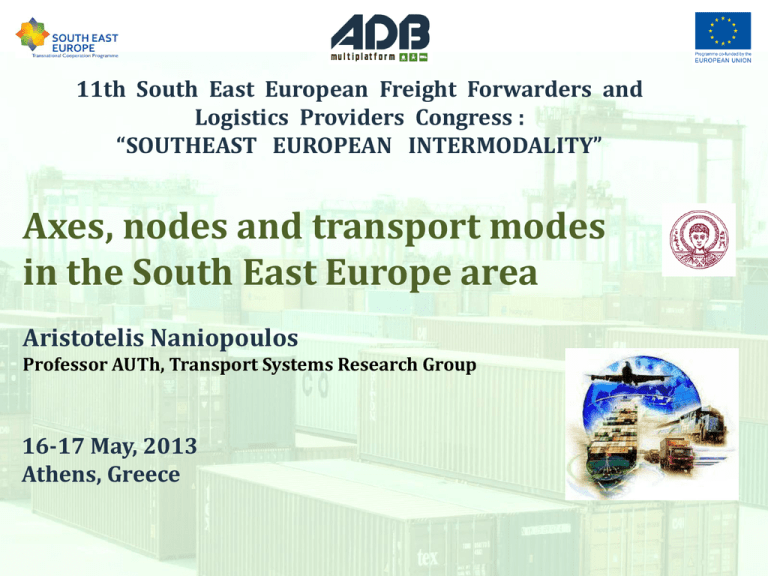
11th South East European Freight Forwarders and Logistics Providers Congress : “SOUTHEAST EUROPEAN INTERMODALITY” Axes, nodes and transport modes in the South East Europe area Aristotelis Naniopoulos Professor AUTh, Transport Systems Research Group 16-17 May, 2013 Athens, Greece The ADB Project in brief (1/2) Title: Adriatic – Danube – Black Sea Multimodal platform. ADB Multiplatform is funded via SEE Programme Duration: 30 months (4 / 2012 - 9 / 2014) Objective: Develop and promote environmentally friendly, multimodal transport solutions from the ports in the SEE programme area (Black Sea, Aegean, Adriatic) to inland countries and regions along a selected pilot transnational network. This will be done by developing and establishing a “multimodal transport development platform”, which integrates different regions and stakeholders from the transport business Partnership: 41 partners The ADB Project in brief (2/2) N Number of partners Countries of Participating partners ERDF: European Regional Development Fund PARTICIPATING COUNTRIES: 13 8 EU countries (Austria, Bulgaria, Greece, Hungary, Italy, Romania, Slovakia, Slovenia) 5 Non EU countries (Albania, Croatia, Montenegro, Serbia, Ukraine) PROJECT PARTNERS: 41 15 ERDF partners, 7 IPA partners, 16 ASP, 3 Observers Mixture of Stakeholders: a) b) c) d) e) Public Authorities Business Associations Freight operators Transport Agencies Research bodies 1 1 2 3 2 9 2 5 2 2 5 3 3 Main ADB Project’s Objectives developing a network of multimodal hubs in SEE area, with common quality and performance standards developing accessibility and trade within SEE area and corridors addressed making multimodal transport a real alternative to road for hinterland traffic catchable by Adriatic/Aegean/Black Sea Ports making rail a reliable solution for economic operators of SEE area enhancement of main rail-river hubs and promotion of rail-water intermodality protecting environment of SEE area The ADB Project Work plan WP1 - Transnational project and financial management WP2 - Communication activities WP3 - Nodes and infrastructure in Adriatic-Danube-Black Sea area WP4 - The ICT backbone of ADB Multimodal Platform WP5 - Multimodal Development Centres (MDC) WP6 - ADB and Green Transport WP7 - Pilot project implementation Why ADB ? Main Intermodal Challenges and opportunities for SEE area SERVING DEMAND FROM-TO 1. Serving demand from-to Far East • An alternative to: The route via Suez and Gibraltar The route via North Sea (NSR) 2. Serving demand from-to Russia MAIN REMARKS • The area should prove in practice that it is a viable and reliable alternative. • Interoperability and Coordination among networks is required • Environmental benefits in global terms should be documented and emphasized • Piracy problems (e.g. Malacce straits, Somalia) should be faced • Important potential export area for SEE products 3. Serving demand from to Turkey and its greater area (Iran, Iraq, Central Asia) • Reactivation of the “old silk road” 4. Serving demand from-to Central Europe • This demand is already served to a certain way. • Possibilities for great improvements • Increased competitiveness of SEE products in CE markets • Important for Regions Cohesion and Coherence 5. Serving intra-regional demand Serving demand from-to Far East An alternative to the route via Suez Canal and Gilbratar An alternative to the route via North Sea (NSR) 7.300 nautical miles 20 days NSR itinerary Indian Ocean itinerary Source: www.ria.ru 11.200 nautical miles 33 days Route characteristics from to Far East Route Suez Canal - Gibraltar Nautical miles 11.200 Time (duration of the route) Other comments 33 days Piracy problems North Sea 7.300 20 days Icebreaker guidance required, Weather conditions, Environment, Crews have to be trained for operations in the Arctic Suez Canal - SEE Varies * 20 – 22 ** Piracy, Low reliability * Time and distance depends on the following: • Port • Transport mode: by rail or by road • Efficiency and performance of terminals ** Example: It is estimated that via Port of Piraeus the time of freight transport to Central Europe (Czech Republic) will be reduced by approximately 8 days compared to the route via Gibraltar. In order to compete the alternative routes SEE must become attractive in terms of the parameters that affect the total time, the total cost, the safety and security the environment. 4 ADB Pilot Routes serving main Demand poles 1st route: Aegean and Black Sea to landlocked countries (Greece to Bulgaria/Romania) “Corridors Χ, IV and IX”. 2nd route: Northern Adriatic to landlocked countries (Austria/Slovakia/Hungary/Serbia "Corridor V”), including the complementary links to Eastern and Western markets. 3rd route: Inter Adriatic “Corridor VIII” and connection of regional and local ICT systems 4th route: Danube River from Slovakia to the Black Sea “Corridor VII”. Pan-European Corridors (PECs) in ADB area Current situation and Available Forecast Road Network • Biggest share of transport flows concentrated on the PECs IV, V and X (less on PECs VIII and IX). • Saturation problems appear only around major cities (Salzburg – Innsbruck, Milan, Bucharest and Sofia). Rail Network • Biggest share of transport flows concentrated on the PECs IV, V and X • Saturation problems: - on the Austrian network - in Slovakia (Bratislava – Gyor) - southwest of Ljubljana on PEC V - on PEC IV (mainly Plovdiv - Haskovo) in Bulgaria Available Forecasts: The EUN STAT (2005), regarding the SEE region, concluded that in year 2020 the freight traffic flows will be concentrated • on the road corridors between Turkey – Bulgaria – Western Balkans – Germany/ Northern Italy and Bulgaria – Romania – Russia • on the railway corridor between Bulgaria – Romania – Ukraine and Russia Available Forecast: SEETAC (2020 & 2030) Volume over Capacity ratio on SEETAC study Rail network – Future situation (2020 left – 2030 right) Volume over Capacity ratio on SEETAC study Road network – Future situation (2020 left – 2030 right) Source: SEETAC: South East European Transport Axis Cooperation,2009-2012,Database on existing physical and operational characteristics/ Forecasts for 2020-2030 Available Forecast: EURO-MED (2025) Year 2000 Year 2025 (medium economic growth) Source: EuroMed Transport Project that aims at improving transport connections between the Euro-Mediterranean Region, leading to economic and social development, and securing safe transport systems,2003-2009 • Traffic volumes between the EU and the neighbouring countries are expected to grow by 100% between 2000 and 2020. Concluding Remarks and Challenges (a) Competition will shape its own intermodal routes …..but we need cooperation to make our area efficient, effective, attractive and promote Development for its citizens…. (b) ADB project provides a unique platform bringing together Authorities and decision makers influencing officials, who may push required changes and face problems on Regional level. (c) Forecasts rarely meet reality SEE area cooperating, step by step, may shape its future market appropriately and make it happen. (d) SE area should face problems and minimise bottlenecks not for merely serving transhipment but also for utilising multiple opportunities particularly in develiping value added activities. (e) SE area should consider internalising externalities, in a way that competition is not distructed, but also citizens and societies will not solely bear that costs. Thank you for your attention! Transport Systems Research Group/AUTh, Contact: naniopou@civil.auth.gr www.tsrg.gr ARISTOTLE UNIVERSITY OF THESSALONIKI TRANSPORT SYSTEMS RESEARCH GROUP



